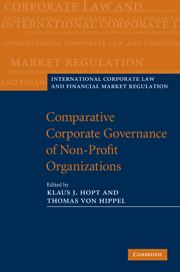Book contents
- Frontmatter
- Contents
- List of contributors
- Preface
- Abbreviations
- PART I Economic findings and theories on nonprofit organizations
- PART II The nonprofit sector: private law, trust law, tax law in selected countries
- PART III The board of nonprofit organizations
- PART IV Good governance of nonprofit organizations: activities and regulatory problems
- PART V Good governance of nonprofit organizations: self-regulation, disclosure and supervision
- 13 Self-regulation
- 14 Disclosure, reporting, auditing
- 14.1 Financial reporting by nonprofit organizations: United States developments
- 14.2 Charity Commission regulation of the charity sector in England and Wales: the key role of charity audit regulation
- 15 Enforcement by state supervision and tax authorities
- Index
- References
14.1 - Financial reporting by nonprofit organizations: United States developments
from 14 - Disclosure, reporting, auditing
Published online by Cambridge University Press: 05 August 2011
- Frontmatter
- Contents
- List of contributors
- Preface
- Abbreviations
- PART I Economic findings and theories on nonprofit organizations
- PART II The nonprofit sector: private law, trust law, tax law in selected countries
- PART III The board of nonprofit organizations
- PART IV Good governance of nonprofit organizations: activities and regulatory problems
- PART V Good governance of nonprofit organizations: self-regulation, disclosure and supervision
- 13 Self-regulation
- 14 Disclosure, reporting, auditing
- 14.1 Financial reporting by nonprofit organizations: United States developments
- 14.2 Charity Commission regulation of the charity sector in England and Wales: the key role of charity audit regulation
- 15 Enforcement by state supervision and tax authorities
- Index
- References
Summary
Introduction
Financial reporting for nonprofit organizations has undergone a sea change in the last 25 years. Pre-1980 fund accounting provided limited, and often obscure, insight into the financial position of nonprofits and the results of their operations. Recent pronouncements, primarily by the Financial Accounting Standards Board, have brought nonprofit organizations under the accounting rules applied to business enterprises. Nonprofits are now required – in conformity with Generally Accepted Accounting Principles (GAAP) – to prepare essentially the same three financial statements as those prepared by business enterprises: Statement of Financial Position, Statement of Activities, and Statement of Cash Flows. With limited exceptions, the same GAAP applies to nonprofits as to business enterprises, with the result that comparability, clarity and reliability of financial reporting have been substantially improved.
Moreover, financial information about nonprofits has in recent years become much more publicly and readily available. A broad group of nonprofits are required to file a federal income tax information return – Form 990 – the contents of which are with limited exceptions public information. The Form 990s themselves, as well as analytical and summary data thereon, are now publicly available on a widely used website. However, the parallels between financial reporting of business enterprises and nonprofits should not be overstated. Thus, while the GAAP principles are parallel, the body of law – primarily federal law – that mandates audit, filing and public availability of the financial statements of a substantial body of the most important business enterprises does not apply to nonprofit organizations.
- Type
- Chapter
- Information
- Comparative Corporate Governance of Non-Profit Organizations , pp. 829 - 848Publisher: Cambridge University PressPrint publication year: 2010



